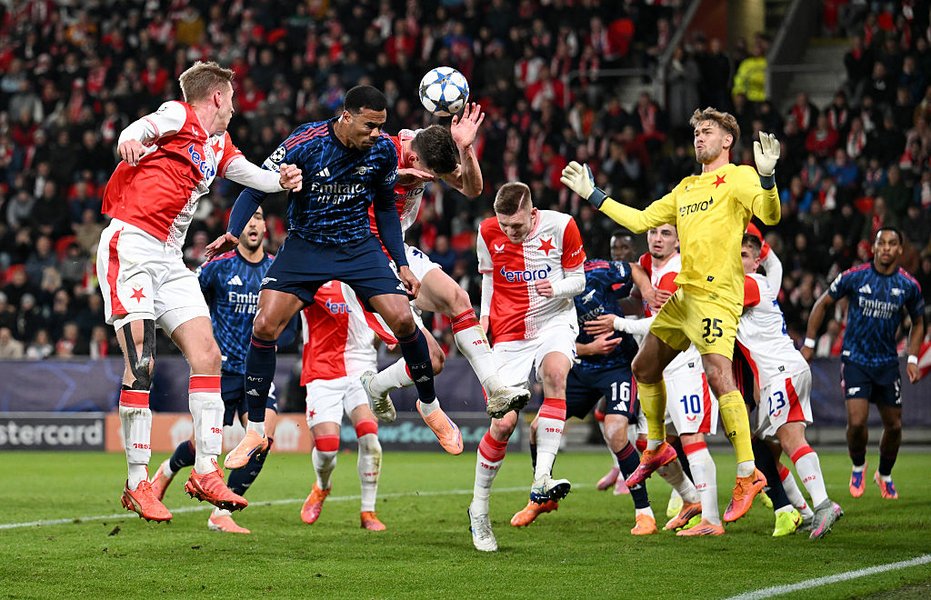

Premier League
Arsenal’s Set-Piece Revolution: How Corners Became Their Deadliest Weapon
Arsenal’s corners are no longer routine set pieces they are statements of intent.
Once a moment of uncertainty, they have now become one of the most feared weapons in English football. Opposition groans echo not from frustration at wasted chances but from the dread of knowing what’s about to come next.
In just their first ten Premier League matches this season, Mikel Arteta’s side have scored eight goals from corners the most at this stage in league history and two more than their nearest rivals, Chelsea.
Add to that a perfect record in the UEFA Champions League, and Arsenal’s newfound strength from dead-ball situations is shaping up as a decisive factor in their hunt for silverware.
The Anatomy of Arsenal’s Killer Corner Routine
Arsenal’s go-to routine has become a familiar yet unstoppable sight: an inswinging corner aimed toward the back post, a towering header down, and a moment of chaos that often ends with the ball in the net.
Declan Rice has emerged as the orchestrator of this set-piece artistry. His precision and power in delivery have been pivotal.
During their recent 2–0 win over Burnley, Rice whipped a cross from the left corner that sailed over the goalkeeper’s outstretched hands, allowing Gabriel Magalhães to nod it down for Viktor Gyökeres to finish from close range.
It’s a sequence that looks telegraphed yet remains almost impossible to defend.
From the right flank, Bukayo Saka adds another dimension. His delivery has proven equally lethal, meaning opponents must remain vigilant from both sides.
The dual-wing threat gives Arsenal flexibility and unpredictability qualities that make their corners nearly unplayable.
Why It’s Working
The magic behind Arsenal’s success isn’t just tactical it’s psychological. Every time Rice places the ball in the corner quadrant, fans in the stands murmur in anticipation while defenders tense up, knowing what’s coming.
The presence of giants like Gabriel, William Saliba, and Riccardo Calafiori inside the box amplifies the pressure. Defenders can’t afford to mistime their jumps or lose focus for even a second.
The smallest lapse could lead to a goal.
VAR has also changed the game. Defenders are now far less likely to engage in blatant holding or shirt-pulling for fear of conceding a penalty, giving attackers slightly more freedom to maneuver.
Arsenal have exploited this new landscape masterfully, turning every corner into a controlled frenzy of movement and precision.
The Opposition Reaction
Ahead of Arsenal’s Champions League clash with Slavia Prague, head coach Jindřich Trpišovský expressed both admiration and apprehension about the Gunners’ set-piece dominance.
“Arsenal’s standards are astounding. I’ve never seen anything like it. They have everything height, power, timing, head play, and, most importantly, Rice’s delivery.”
His words reflect a wider recognition across Europe: Arsenal have evolved beyond their possession-heavy stereotype. They’ve become a hybrid side capable of blending technical sophistication with brute-force efficiency.
Stopping Arsenal’s corner routine is proving a near-impossible task.
Neutralizing Gabriel might seem the obvious strategy, but doing so for a full 90 minutes often leaves space for others to strike. Arsenal have diversified their threats so well that shutting down one avenue simply opens another.
Set-Pieces in Context
Football evolves in cycles. For years, the emphasis was on pressing intensity and short, intricate passing a trademark of Pep Guardiola’s Manchester City and Arteta’s early Arsenal.
But as defenses adapt and pressing becomes more suffocating, teams are looking for direct solutions.
Enter the set-piece revolution.
Across Europe, set-piece coaches, data analysts, and performance specialists are becoming as integral to a team’s success as traditional assistant managers.
Arsenal’s precision under Nicolas Jover, their set-piece coach, shows just how far elite teams are willing to go to exploit every marginal gain.
The Long Throw-In Renaissance
Arsenal’s dead-ball mastery sits within a broader tactical shift that’s quietly reshaping football the return of the long throw-in.
Once dismissed as a crude tactic from a bygone era, the long throw is back. The ghost of Rory Delap, the Stoke City cult hero whose missile-like throws terrorized defenses in the 2000s, now hovers over Premier League grounds once again.
Statistics show that the number of long throw-ins per match has more than doubled this season. Clubs like Brentford, Tottenham, Manchester United, and even Arsenal are using them to create chaos inside the box.
Pundits like Jamie Carragher have voiced disapproval, arguing that long throws disrupt the rhythm of the game. Lawmakers are even debating whether to curb their influence.
Yet the numbers don’t lie long throws are effective. They provide direct entry into the danger zone and offer smaller teams a way to compete physically with the elite.
Brentford’s data-driven approach typifies the trend: if a long throw statistically yields a similar chance creation rate to a short corner, why not use it?
Arsenal’s willingness to blend the pragmatic with the aesthetic shows that even top teams are not above going “route one” when it makes sense.













